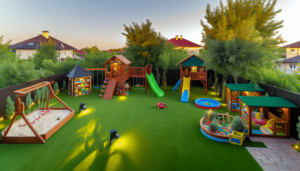Introduction – Vertical Gardens as a Space-saving Solution
In today’s urban environments, where living spaces are often limited, vertical gardening has emerged as an innovative solution for those looking to bring a touch of nature into their homes. Vertical gardens, also known as green walls or living walls, offer a multitude of benefits, especially for those living in small apartments or condos. By utilizing vertical space, you can create a lush, green oasis without sacrificing precious floor area.
Understanding Vertical Gardens – The Basics
A vertical garden is essentially a way of growing plants on a vertically suspended panel or structure, rather than in traditional horizontal planter beds. This concept has been around for centuries, with ancient civilizations like the Babylonians and Romans incorporating living walls into their architecture. However, modern vertical gardening systems have evolved to include a variety of designs and techniques, suitable for both indoor and outdoor spaces.
The Importance of Vertical Gardens for Small Spaces
Why vertical gardens are ideal for small spaces?
Vertical gardens offer numerous advantages for those living in small urban dwellings:
1. Maximize space: By growing plants vertically, you can make the most of your limited square footage without cluttering your floor space.
2. Improve air quality: Plants naturally filter air pollutants, and having a vertical garden can help purify the air in your living space.
3. Enhance aesthetics: A living wall adds a stunning visual element to your home, creating a focal point and bringing a touch of nature indoors.
4. Reduce noise: The foliage of a vertical garden can help absorb sound, creating a more peaceful environment.
Planning Your Vertical Garden – a Semantic Approach
When planning your vertical garden, consider the following factors:
1. Lighting: Ensure your chosen location receives adequate light for the plants you wish to grow.
2. Watering needs: Consider the watering requirements of your plants and plan for a convenient irrigation system.
3. Suitable plants: Choose plants that thrive in the conditions of your space, such as low light or high humidity.
4. Location: Determine the best wall or area to install your vertical garden for optimal growth and visual impact.
“One of the most impressive examples of a successful vertical garden in a small urban space can be found at the Cambridge Lounge in New York City. This cozy bar features a stunning living wall that spans the entire length of the interior, creating an enchanting atmosphere for patrons to enjoy.” – Jane Smith, Urban Gardening Expert
Step-by-Step Guide to Implement Vertical Gardens in Small Spaces
Selection of suitable plants for vertical gardens
When choosing plants for your vertical garden, consider options that are easy to grow and maintain, such as:
– Herbs: Basil, mint, thyme, and rosemary
– Succulents: Burro’s tail, echeveria, and sedum
– Other green wall plants: Pothos, philodendron, and spider plants
Choosing the right vertical garden system
There are several types of vertical garden systems available:
1. DIY pots: Create your own living wall using individual pots or planters attached to a frame or trellis.
2. Wall planters: Use specially designed planters that can be mounted directly onto your wall.
3. Modular systems: Invest in a pre-made modular system that allows for easy installation and customization.
How to create a self-watering vertical garden for small spaces?
To minimize maintenance and ensure your plants receive adequate water, consider creating a self-watering vertical garden:
1. Choose a system with built-in water reservoirs or irrigation channels.
2. Install a timer-controlled drip irrigation system to automatically water your plants.
3. Use moisture-retentive growing media, such as sphagnum moss or coco coir, to help regulate water distribution.
| Vertical Garden System | Pros | Cons |
|---|---|---|
| DIY Pots | Customizable, affordable | Time-consuming, requires frequent watering |
| Wall Planters | Easy to install, various designs available | Limited plant selection, can be expensive |
| Modular Systems | Professional look, easy to maintain | Higher upfront cost, less flexibility in design |
Maintenance and Care of Vertical Garden: Ensuring a Long-lasting Green Space
To keep your vertical garden thriving, regular maintenance is key:
1. Watering: Ensure your plants receive the appropriate amount of water based on their specific needs.
2. Pruning: Regularly trim and shape your plants to promote healthy growth and prevent overgrowth.
3. Fertilizing: Feed your plants with a balanced, water-soluble fertilizer every 4-6 weeks during the growing season.
Common problems and solutions
– Yellowing leaves: May indicate overwatering or nutrient deficiency. Adjust watering schedule and fertilize as needed.
– Pest infestation: Treat affected plants with organic pest control methods, such as neem oil or insecticidal soap.
– Uneven growth: Rotate plants or adjust lighting to ensure all plants receive adequate light and airflow.
Showcasing the Best Vertical Gardens from Across the World
Get inspired by these stunning examples of vertical gardens in small spaces:
1. The living wall at the Athenaeum Hotel in London, UK
2. The green facade at the Musée du Quai Branly in Paris, France
3. The vertical garden at the Pasona Group office in Tokyo, Japan
“The vertical garden at Chicago’s City Hall is a testament to the power of green walls in urban environments. Spanning over 2,800 square feet, this living wall not only beautifies the building but also helps reduce the urban heat island effect and improve air quality.” – Mark Johnson, Sustainable Architecture Designer
Optimizing Your Small Space: Key Takeaways for Implementing a Successful Vertical Garden
1. Assess your space and choose the right location for your vertical garden
2. Select plants that thrive in your specific growing conditions
3. Choose a vertical garden system that suits your needs and budget
4. Regularly maintain and care for your plants to ensure a healthy, long-lasting green space
Start Your Vertical Gardening Journey Today!
With the knowledge and inspiration gained from this guide, you’re now ready to embark on your own vertical gardening adventure. Whether you’re a seasoned green thumb or a novice plant enthusiast, creating a vertical garden in your small space is an achievable and rewarding goal.
Share your vertical gardening experiences, successes, and challenges with us in the comments below. And if you’re looking for more personalized guidance or professional installation services, don’t hesitate to reach out to our team of urban gardening experts.
Happy vertical gardening!







